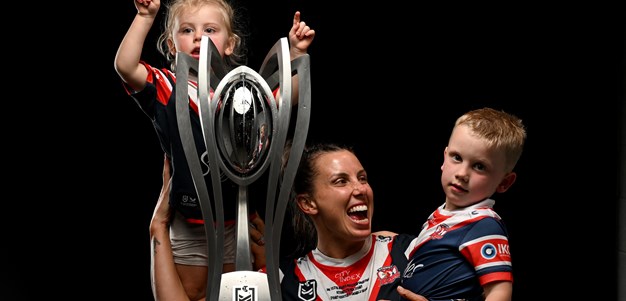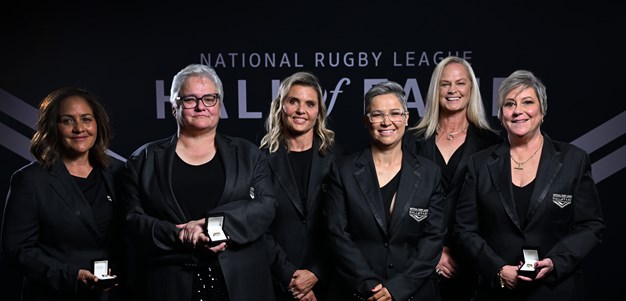It looks like you may be using adblocking software to view this site.
Many features on the site, such as video playback, may not work properly when using adblocking software.
Please whitelist our domain or disable your adblocker to access all features and videos.
Josh Addo-Carr has written an Indigenous song that he and his team-mates have been practicing ahead of Saturday night’s clash with the Maori All Stars at CommBank Stadium and hope fans will sing at future matches.
The song, which the Indigenous players performed for their women’s team at the end of training on Friday, is just one example of how significant the cultural aspect of the annual All Stars clash has become since the introduction of the Maori team in place of the World All Stars four years ago.
When the All Stars concept began in 2010, pioneers of the game hoped the match would be an opportunity to educate players and fans about their culture and history.

They have been so successful that young players such as Will Kennedy, Braydon Trindall and Tyrell Sloan now arrive in camp with a thirst for knowledge and a desire to showcase Indigenous culture to the crowd at the stadium and millions watching on television.
Yet after an inspiring Welcome to Country event at Western Sydney Zoo on Tuesday for the rival men’s and women’s teams, Indigenous leaders Laurie Daley and Dean Widders noted that with each advance the Indigenous team make in the culture stakes their Maori counterparts rise the bar even higher.
As hard as the teams compete on the field, they are also driving each other off it and the result was what Daley described as the best All Stars camp he has been involved with since taking charge of the Indigenous team in 2011.
It looks like you may be using adblocking software to view this site.
Many features on the site, such as video playback, may not work properly when using adblocking software.
Please whitelist our domain or disable your adblocker to access all features and videos.
Preparation to execution: The Maori haka
“There is just a different feel,” Daley said. “The young guys have come in and fitted in so well.
"They are very proud of who they are, they feel comfortable in this space and I think that they will go back being better players and men within their own footy clubs and footy teams.”
When Widders, the NRL Indigenous pathways manager, first proposed the team develop a dance at a camp in 2014, there was some apprehension from players as few grew up surrounded by Indigenous culture.
Arguably the most significant reason for Indigenous players losing touch with their heritage is the Stolen Generation and there will be a moment’s silence before the game to honour the victims on the eve of Sunday’s anniversary of Kevin Rudd’s 2008 apology to the nation.
A moment’s silence will also be held before kick-off to honour Maori and Pacifika trailblazer Olsen Filipaina, along with Immortals and former St George team-mates Norm Provan and John Raper, who have all recently passed away.
Maori coach David Kidwell paid tribute to Filipaina, who passed away on Thursday at Westmead Hospital after suffering kidney failure, and he noted that while ‘The Big O” had been one of the first Kiwis to play in the premiership, Polynesians now comprised 45 per cent of NRL talent.
The rise of players from New Zealand and the Pacific nations has coincided with a greater focus on culture within the game and the sound of Indigenous players rehearsing the Unity Dance or the Maori side practicing the haka has reverberated around Sydney’s Olympic Park this week.
The women’s teams have also been working on their versions of the war cries at their St Marys base, with the Maori women learning a waiata (traditional song) until 11.30pm Monday to perform at 7.30am Tuesday.
“It’s been a very special week and there have been some tears, so it is going to be a special game,” said Addo-Carr. “There is just so much emotion that goes into it. This week we learned a hell of a lot and we have got something special coming up.”
It looks like you may be using adblocking software to view this site.
Many features on the site, such as video playback, may not work properly when using adblocking software.
Please whitelist our domain or disable your adblocker to access all features and videos.
Insta captain: How Addo-Carr learned about his proudest moment
The teams have had cultural leaders in camp with them and fans can expect to see changes to the hakas and unity dances performed by the men’s and women’s teams last year in Townsville.
“The Maori boys are raising the bar with how serious they are about their culture and we are getting to that level of showing that strength and that pride as well,” Widders said.
“Before we had to take guys on a bit of a journey but now they come in ready for that and they expect it.
“Josh even wrote a song. He has put it in traditional language and the boys love it, and they have all been singing it. It shows a lot of cultural meaning behind the stuff that we are doing in this song.
“The boys have been practicing it and they want to perform it at different times. It is going to be a powerful thing.”
'Ready for war'
The Maori players have had daily haka sessions under the supervision of their Australian-based cultural advisor Andre Ahipene, whose input into the preparation for Saturday night’s match is valued by Kidwell and team management.

Penrith prop James Fisher-Harris said performing the haka before kick off readied him for the match.
“It is just raw. I am ready to go to war, that’s it for me,” Fisher-Harris said. “I only do it before going to war. It just gees you up that much. That is what it is for and that is how it feels.”
Fisher-Harris took part in a photo shoot on Sydney Harbour late last year to launch the All Stars match and he bought along traditional Maori artefacts belonging to his family for himself and his daughter, Tahira, to pose with.

“I lived with one of my uncles over here when I was younger and his son had most of those artefacts, like the patu (club) and the taiaha (staff),” Fisher-Harris explained.
“Even the cloak that I wore – the korowai - they blessed it for me to wear. That was pretty cool. They made one for my daughter too. My old man made that korowai too, that she is wearing, back in NZ. He gave it to me in 2019 and I bought it back to Australia.
“Playing for the Maori team is probably the highest honour, I reckon, because it means so much to my family back home and all who went before them.
“There are a lot of Maoris who live in Australia and for them to come to a game and see us represent our families and everyone who has gone before us is pretty cool but hopefully we can have it in New Zealand next year or in the future.”
'Fierce but feminine'
The haka that the Maori women’s team perform is similar but has some notable differences and they too have been practicing regularly, with players holding fortnightly online cultural sessions since last year’s match.
It looks like you may be using adblocking software to view this site.
Many features on the site, such as video playback, may not work properly when using adblocking software.
Please whitelist our domain or disable your adblocker to access all features and videos.
Maori women's haka
“Our haka is similar to last year but we are always practicing to make sure it is sharp and fierce,” Eels fullback Botille Vette-Welsh said. “We pretty much practice every day.
“The haka that the men do is about empowering men, and the one that the women do is about how important a woman is in Maori life so they are different. We want to be staunch and fierce, but feminine at the same time.”
Vette-Welsh, whose father Alfred was a te reo Maori teacher in New Zealand before the family moved to Australia, explained the subtle differences between the hakas performed by the men’s and women’s teams but she said the impact was the same.

“The boys do their tongues out; we don’t do our tongue out,” she said. “We do similar things with different actions. The boys go up [raise their hands]; we don’t go up with our arm pits showing. We need for our actions to be feminine but staunch.
“We have the same thought process. We are ready to go to war. It is just about being staunch but fierce and setting down the challenge.
“Back in the day it was obviously about going to war but here it is about who is the most dominant, who is the most powerful. It is done with respect to our Indigenous sisters, but when it comes to the haka we do it to try and scare, while looking pretty at the same time.”
'That dance is mad'
The dance performed by the Indigenous women’s team differs from the one initially developed under the guidance of Widders by the men’s team for the 2015 All Stars match.
It looks like you may be using adblocking software to view this site.
Many features on the site, such as video playback, may not work properly when using adblocking software.
Please whitelist our domain or disable your adblocker to access all features and videos.
Indigenous women's unity dance
It has also evolved as different players have come into the team and last year a choreographer helped them make changes to reflect the inclusion of players with Torres Strait Islander heritage.
“We just based it off our ancestors and all the objects they used,” Dragons star Shaylee Bent said.

The players lined out in the shape of a coolamon, which is traditional carrying vessel shaped like a canoe.
“You could put your babies in it, or berries you picked,” explained Bent, who is a proud Wiradjuri and Biripi woman.
“We started off in a circle shape, we did that because we are all as one. We had powder in our hands that was meant to be ochre and we were grabbing as one and taking our ancestors with us and then we would leave the circles and we would walk.
“We would pick berries because that is what Aboriginal women used to do.”
Assistant coach Jess Skinner said that the women’s unity dance was based around four elements – earth, wind, water and fire.
The Indigenous women’s leadership group last year decided which actions to keep before refining the dance.
“They wanted to make sure more of our Torres Strait Island sisters were represented in it too. That's where the water motion is represented.
“With this year's group they were able to bring more of themselves into the dance. 2021 was about setting a foundation. From that foundation the group can add in whatever suited them and the local people.
“We had an Aunty visit us this week from the Darug land we're on and she wanted us to have soft movements with our feet so we make sure when we move across her country that we do that.
“We want girls in the middle of NSW, all the way to the top end and Western Australia, one day to be represented as a complete unity dance.”
Knights prop Caitlin Johnston said the players hoped the dance would be widely adopted with the community.

“For us it is a big unity dance. We get to showcase and dance our Aboriginal totems and we get to also represent the TI girls, as well. with some of the moves they have up there
“We want our younger generation coming through to say ‘I want to dance that dance, that dance is mad’.”





